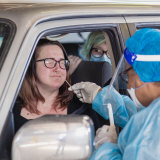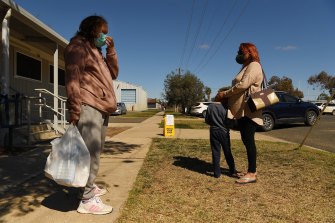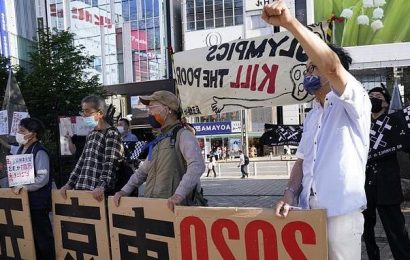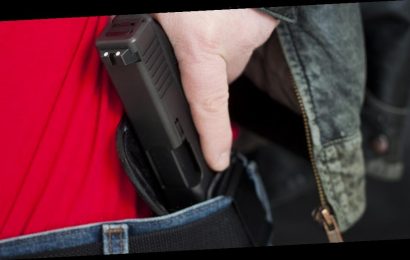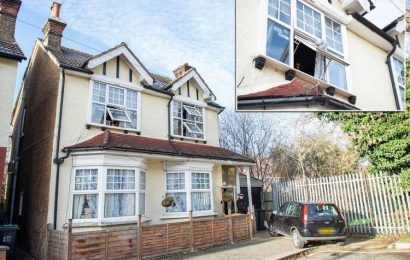For our free coronavirus pandemic coverage, learn more here.
Wiradjuri mother Tiani Bartlett waits patiently in bumper to bumper traffic in her car with the family. It’s the kind of congestion that wouldn’t be out of place in Sydney’s CBD. But this traffic jam is in Dubbo, about 400 kilometres west of the nation’s largest city. After three hours, Bartlett gets a coronavirus test: 19 months after landing on Australian shores, COVID-19 has finally arrived in Dubbo.
Residents wait for a COVID-19 outside a walk-in clinic in Dubbo. Credit:Kate Geraghty
Bartlett lives with her partner and six children in the regional city of 38,000, according to the last census. Despite being eligible for a COVID-19 vaccine because she is Indigenous, she has yet to book in for a jab. “No, we have not been vaccinated yet,” she says. But with a coronavirus outbreak spilling out from Dubbo into nearby communities with large Aboriginal populations, she says her family is now planning to get vaccinated when they can. Indigenous children over 12 are now eligible, and she wants her children to get vaccinated. “It’s something we recently came to a decision that we would like to, given the statistics between the risks of getting COVID and getting the vaccine,” she says.
Aboriginal and Torres Strait Islander people have been a priority group in the vaccination rollout since planning began because they’re considered more vulnerable to the virus.
The reasons are numerous. Many Indigenous people live with a higher burden of disease, meaning they also have other chronic illnesses like diabetes or kidney disease. Indigenous people living in remote and regional communities also often live in overcrowded housing and have poorer access to quality healthcare due to their locations. “Indigenous Australians were one of our greatest concerns at the start of this pandemic,” Prime Minister Scott Morrison said in December. “They always have been a very clearly defined, vulnerable community, like Australians with disability, like older Australians.”
Wiradjuri woman Tiani Bartlett getting a COVID-19 test in Dubbo. She is looking to have her entire family vaccinated.Credit:Luke Hibbard
Despite these assurances, the vaccination numbers for Indigenous people are alarmingly low in some areas as COVID-19 makes its way through Aboriginal communities in western NSW. Statewide, NSW had a full vaccination rate for Indigenous people of just 8.6 per cent as of August 15. In Western Australia, that figure was 4.9 per cent. Victoria was leading the way, with 36.5 per cent. The national figure was a mere 15 per cent, compared to 26.2 per cent in the general population.
Aboriginal people in western NSW have told the Herald and The Age that people are concerned for their communities, and aren’t sure how the local health systems will cope.
Courtney Boney, 27, and four of her relatives were vaccinated at a pop-up clinic in Brewarrina earlier this week, but she says it wasn’t an easy decision to make. “It’s just scary, hard,” she says. “Some people are like, ‘well, it doesn’t really matter, either way we’re all going to die’. Then other people are like, ‘no, we’ve got to get the COVID shot, it’s the only way to be safe’.”
Members of the Boney family wait for other relatives outside the Ochre medical centre in Brewarina.Credit:Kate Geraghty
Given all Indigenous people over 16 have been eligible for vaccinations since early June — and those over 55 before that — questions remain over why the rates for a critical priority group are still so low. The medical director of the National Aboriginal Controlled Community Health Organisation, Jason Agostino, said on Monday that the Indigenous health sector needed the support of the state and federal governments to get jabs into arms. “It’s really clear that Aboriginal health services can’t do this on their own, we’ve more than doubled the number of vaccines we’ve given in the last five weeks, but the gap in vaccination coverage is still there,” Dr Agostino said.
Two COVID-19 cases were detected in the towns of Dubbo and Walgett last Tuesday. By this Friday, the cluster had grown to 194 and had spread to more remote towns like Bourke and Broken Hill. Most cases have been in Aboriginal people – many of them children.
The situation has appeared to rattle the federal and NSW governments. The state’s Health Minister, Brad Hazzard, told the Herald and The Age that the full vaccination rate for Indigenous people in the region was as low as 7.6 per cent on August 12, when the areas went into lockdown.
”We do see it as a serious situation and we’re moving quickly to work with the NSW government to address it,” Morrison said on Tuesday, after announcing the Defence Force would be sending medical teams to help with the rollout in western NSW.
The announcement came less than a week after more than 7500 vaccine doses were urgently sent to the region. “The idea that vaccines had to be rushed out to western NSW suggests to me one thing, and that’s that there was an absence of vaccines in the first place,” said Labor’s spokeswoman for Indigenous Australians, Wiradjuri woman Linda Burney.
It is a message being echoed by many Aboriginal organisations across the country — the National Aboriginal Controlled Community Health Organisation says adequate supplies of the Pfizer vaccine didn’t start arriving in Aboriginal communities until July.
Bundjalung woman and chief executive of the Gandangara Aboriginal Land Council in Liverpool, Melissa Williams, says there are three key problems with the rollout. “Part of the reason we are in this mess at the moment is because of the mixed messaging, the slow rollout of vaccines, and not being quick enough to act,” she argues.
Crucially, she says the federal government has not done enough to address hesitancy in the community through its communications strategy.
Tharawal Aboriginal Corporation’s operations manager, Thungutti man Lachlan Wright, agreed. “What do people do when they don’t have access to the right information? They look on social media,” he says.
These smaller organisations aren’t alone. Peak Indigenous health bodies across the country have reported serious concerns about anti-vaccination messaging and hesitancy.
While Labor has hammered the federal government over its strategy for vaccinating First Nations people, Minister for Indigenous Australians Ken Wyatt is insisting that the number of vaccinations is increasing rapidly. “Some people have made choices because they have become fearful of adverse effects, but now they are focusing on getting vaccinated,” he said.
He also defended the government’s advertising campaign: “The messages were going out through Aboriginal media … but in some places, they thought they would be fairly distant from what was happening in capital cities, there is now a realisation that this virus can travel anywhere.”
The federal government will also soon launch a vaccination campaign featuring former AFL star Adam Goodes.
Latisha Carr-McEwan and her children at a Dubbo testing clinic on Monday. Credit:Kate Geraghty
History has taught Australia that the consequences of failing to manage pandemics can be catastrophic for Indigenous communities. During the Spanish flu pandemic in 1919, the Barambah Aboriginal Settlement in Queensland — now called Cherbourg — was one of the hardest-hit communities in the country: 590 of the 600 inhabitants caught the virus, and 90 of them died, with a mortality rate of 15 per cent.
While the federal government rolls out its new advertising campaign and ramps up vaccination supply in western NSW, for a growing number of Aboriginal people infected with the virus it’s too late for a jab. But, according to the Aboriginal community-controlled health sector, with enough hard work and funding, it’s not too late to turn the numbers around.
with Jenny Noyes
Most Viewed in National
From our partners
Source: Read Full Article

